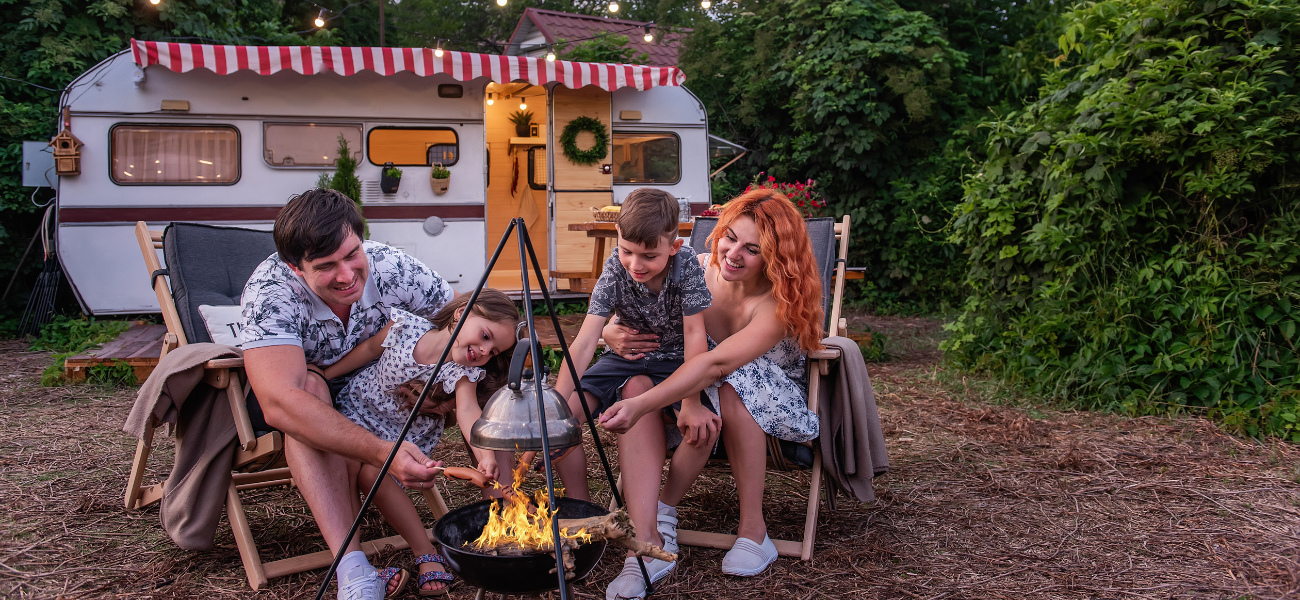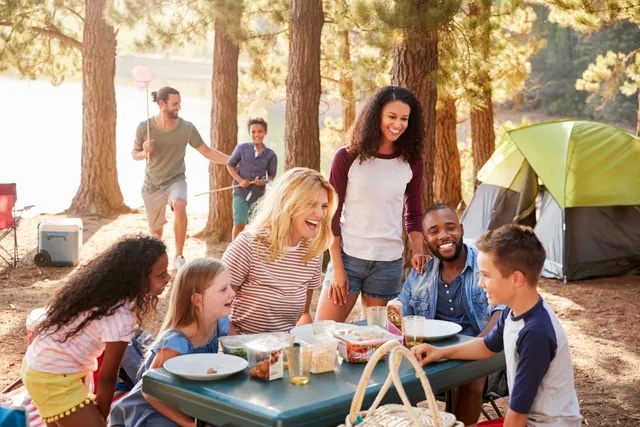Family Camping Trips and Lice Prevention: A Complete Parent’s Guide
Introduction

Family camping trips are one of those rare opportunities when everyone can truly step away from the fast pace of daily life and reconnect with one another in a relaxed, natural setting. They offer a chance to leave behind the screens, the deadlines, and the endless to-do lists, and instead focus on shared experiences — setting up camp together, preparing meals over a fire, telling stories under the vast, star-filled sky, and waking up to the gentle sounds of nature rather than an alarm clock. Whether you’re spending the weekend at a local campground, taking the RV on a cross-country adventure, or simply pitching a tent in the backyard to give the kids a taste of the outdoors, these moments have a way of becoming cherished family memories.
But as any seasoned camper knows, the outdoors also comes with its own set of challenges and considerations — and while most people think about packing bug spray to ward off mosquitoes or taking precautions against ticks, there’s another small but persistent pest that can appear even in the most scenic, remote locations: head lice. Many families associate lice primarily with schools, daycares, or large summer camps, but the truth is that camping trips, especially those with multiple families or large groups of friends, can also create conditions where lice are more likely to spread.
Close sleeping arrangements, sharing bedding or pillows, swapping hats or hooded sweatshirts when the evenings get cool — these are all normal, innocent parts of the camping experience, but they can also provide the ideal environment for lice to move from one person to another. And because camping often takes place in areas far from the convenience of a pharmacy or professional lice removal service, prevention and preparation become even more important. This guide will walk you through everything you need to know to keep your trip enjoyable and lice-free, from understanding exactly how lice spread, to setting up prevention habits, to knowing what steps to take if lice are discovered mid-trip.
Understanding Head Lice
What Are Head Lice?
Head lice (Pediculus humanus capitis) are tiny, wingless insects that live on the human scalp and feed on small amounts of blood several times a day. Fully grown adult lice are typically the size of a sesame seed, while newly hatched nymphs are even smaller and can be nearly invisible to the untrained eye. Their coloring can range from almost translucent to darker brown or gray, depending on the host’s hair color and the lighting, which makes them well camouflaged.
Female lice lay eggs, known as nits, that are oval in shape and yellowish-white in color. These eggs are firmly attached to the hair shaft with a glue-like substance, which is why they do not wash away or flake off like dandruff. Nits are most often found close to the scalp, where the warmth of the body provides an ideal environment for incubation. They hatch within 7–10 days, and the newly emerged nymphs mature into adults capable of laying their own eggs in just over a week. Without intervention, this cycle repeats rapidly, allowing lice populations to increase quickly and making early detection essential.
How Do Lice Spread?
Contrary to popular belief, lice do not jump or fly; they move by crawling, and they require close proximity between heads to transfer from one person to another. The most common way lice spread is through direct head-to-head contact— moments when hair touches hair. This can happen during hugs, when sitting close together, or while lying next to someone.
While less common, lice can also be transmitted through personal items that have been in recent contact with an infested scalp, such as hats, scarves, hooded sweatshirts, hairbrushes, or bedding. On a family camping trip, these items are often shared or stored together, making it important to take simple precautions to reduce the risk.
Why Camping Trips Can Increase Lice Risk
1. Close Sleeping Arrangements
Camping often means sharing sleeping space in a tent or small cabin, where beds or sleeping bags are positioned close together. Even if each family member has their own bedding, it’s easy for heads to touch during the night — especially with children, who may toss and turn or scoot closer for comfort. In some cases, kids may even switch sleeping spots to be next to friends or siblings, further increasing the chances of direct head-to-head contact.
2. Shared Bedding and Gear
In the casual, communal atmosphere of a camping trip, it’s common for people to share blankets when sitting around the campfire, loan a pillow to a cousin, or use a sibling’s sleeping bag for a nap. If an item has recently been used by someone with lice, those insects can survive on it for 24–48 hours, giving them time to crawl onto a new host.
3. Group Activities
Hikes, games, and campfire sing-alongs bring people close together — and kids, in particular, tend to huddle close, lean against each other, or link arms during these moments. Such physical closeness is part of what makes camping feel warm and connected, but it’s also exactly the type of contact that lice rely on to spread.
4. Extended Time Together
Unlike a quick visit to the park or a day trip, camping keeps people in close proximity for days or even weeks at a time. If one person arrives with lice, the extended time frame allows more opportunities for transmission before the infestation is noticed.
Preparing for a Lice-Free Camping Trip

Step 1: Perform a Pre-Trip Lice Check
Before heading out, it’s a good idea to check every family member for lice — especially children, since they are more likely to have close head-to-head interactions.
How to do it:
- Sit the person in a well-lit spot, preferably near natural light.
- Lightly dampen the hair and apply conditioner to make combing easier and slow any lice movement.
- Use a fine-toothed lice comb, working through small sections from scalp to ends.
- After each pass, wipe the comb on a white paper towel and inspect for lice or nits.
If lice are found, treat them before the trip begins. This avoids spreading them to other family members during the outing.
Step 2: Pack Lice Prevention Essentials
Your packing list should include more than the usual camping gear. Add:
- A fine-toothed lice comb for quick checks
- A small bottle of conditioner
- A natural lice-repellent spray containing tea tree, rosemary, or citronella oil
- Personal pillowcases for each person
- Ziplock bags for hair accessories or hats
- Extra hair ties and headbands
Step 3: Educate Kids Before the Trip
Explain in age-appropriate terms why it’s important to avoid sharing hats, pillows, and brushes. Encourage them to keep their hair tied back and to let you know right away if they notice any itching or discomfort.
Preventing Lice While Camping
Keep Bedding Separate
Assign each person their own bedding and keep it stored in individual bags when not in use. This helps avoid accidental sharing and ensures that if lice are present, they don’t have easy access to multiple people.
Maintain Protective Hairstyles
Long hair should be kept in braids, buns, or ponytails to minimize loose strands that could come into contact with others’ hair.
Use Lice-Repellent Spray Daily
Spraying hair each morning before activities can help deter lice. Focus on the hairline, behind the ears, and the nape of the neck — areas lice target first.
Limit Sharing of Personal Items
Even when camping with close family and friends, avoid swapping hats, hoodies, hairbrushes, or headphones. Small habits like this can significantly reduce the chance of lice transmission.
Detecting Lice on the Trip
Early Signs
Watch for:
- Persistent itching, especially behind the ears and at the nape of the neck
- Small red bumps or sores along the hairline
- Nits glued to the hair shaft close to the scalp
On-the-Spot Checks
If you suspect lice, use your prevention kit’s comb and a flashlight to check. While this won’t be as thorough as a home inspection, it can help you identify problems before they spread.
What to Do If You Discover Lice While Camping

- Separate belongings — Place bedding, hats, and recently worn clothing in sealed bags until they can be washed in hot water.
- Limit contact — Keep the affected person’s head away from others until treatment is complete.
- Check everyone — If one person has lice, others in close contact are at risk and should be examined.
- Start treatment — If near a town, seek a professional service. If remote, begin with thorough combing and plan for professional follow-up after returning home.
Post-Trip Lice Prevention
After returning:
- Wash all bedding and clothing in hot water and dry on high heat.
- Bag unwashable items for at least 48 hours.
- Perform thorough lice checks on all family members.
- Repeat checks weekly for several weeks to ensure the infestation is gone.
Myths and Facts About Lice and Camping
Myth: Sleeping outdoors kills lice.
Fact: Lice live on the scalp, which remains warm enough for survival in most camping conditions.
Myth: Lice can jump between sleeping bags.
Fact: They cannot jump or fly; they crawl, usually during direct contact.
Myth: Campfire smoke repels lice.
Fact: There is no scientific evidence to support this.
FAQs for Families
Q: Can lice spread through tents?
A: Only if infested bedding or pillows are shared.
Q: Do lice live in the wild?
A: No, they need a human host to survive.
Q: Should we cancel our trip if someone has lice?
A: Not necessarily — with prompt treatment and precautions, you can still enjoy your plans.
Expert Tips from LiceDoctors for Camping Trips
- Start lice prevention routines a week before leaving.
- Keep a lice kit in your camping gear.
- Assign unique pillowcases to each person.
- Include a post-trip lice check in your unpacking process.
How LiceDoctors Can Help
If lice are found before, during, or after your trip, LiceDoctors offers:
- In-home, all-natural removal
- Same-day service
- Prevention education for the whole family
- A 99.6% success rate
Conclusion
Camping trips create unforgettable memories, but they also bring families into close contact — the perfect environment for lice to spread if you’re not careful. By checking everyone before you go, packing a few prevention tools, and being vigilant during and after your trip, you can minimize the risk and keep your focus on the adventures that matter. And if lice do appear, professional help can resolve the problem quickly so you can get back to enjoying your time together.


